Choosing a Gaming CPU at 1440p: Adding in Haswell
by Ian Cutress on June 4, 2013 10:00 AM ESTCPU Benchmarks
Point Calculations - 3D Movement Algorithm Test
The algorithms in 3DPM employ both uniform random number generation or normal distribution random number generation, and vary in amounts of trigonometric operations, conditional statements, generation and rejection, fused operations, etc. The benchmark runs through six algorithms for a specified number of particles and steps, and calculates the speed of each algorithm, then sums them all for a final score. This is an example of a real world situation that a computational scientist may find themselves in, rather than a pure synthetic benchmark. The benchmark is also parallel between particles simulated, and we test the single threaded performance as well as the multi-threaded performance.
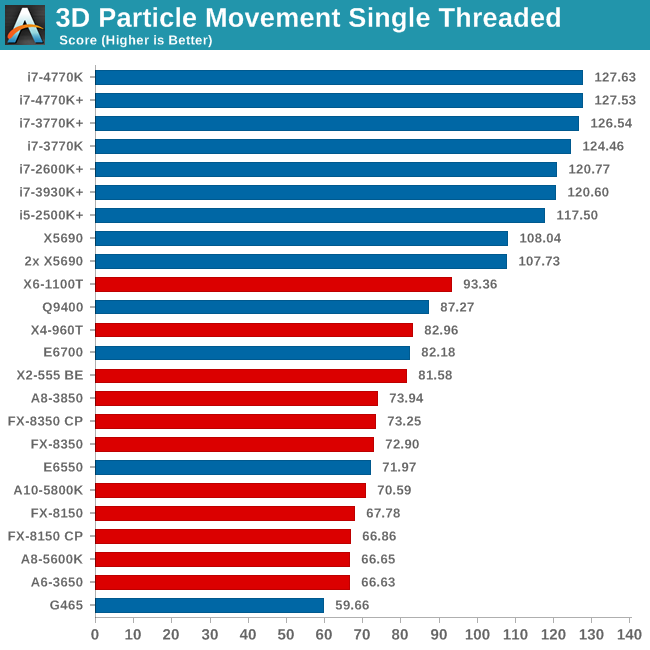
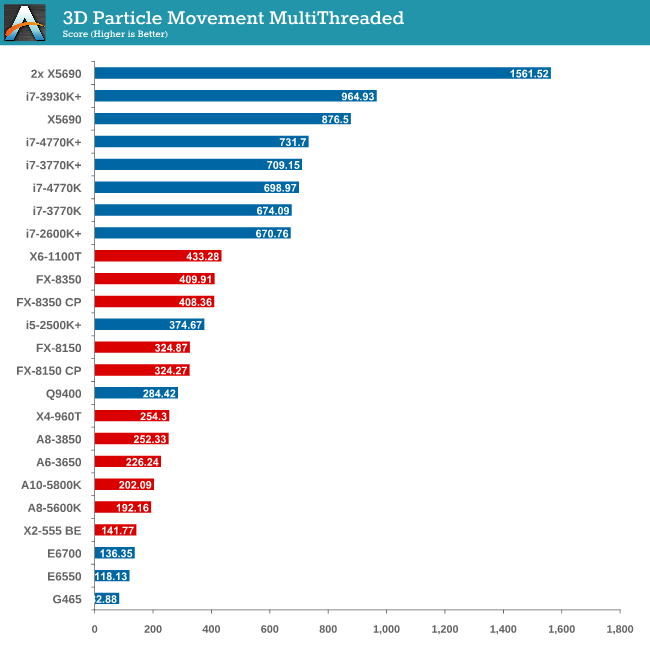
As mentioned in previous reviews, this benchmark is written how most people would tackle the situation – using floating point numbers. This is also where Intel excels, compared to AMD’s decision to move more towards INT ops (such as hashing), which is typically linked to optimized code or normal OS behavior.
The 4770K comes in top in single threaded performance, showcasing the IPC gains of the new architecture. This is also shown in multithreaded tests with MCT both off and on.
Compression - WinRAR x64 3.93 + WinRAR 4.2
With 64-bit WinRAR, we compress the set of files used in our motherboard USB speed tests. WinRAR x64 3.93 attempts to use multithreading when possible and provides a good test for when a system has variable threaded load. WinRAR 4.2 does this a lot better! If a system has multiple speeds to invoke at different loading, the switching between those speeds will determine how well the system will do.
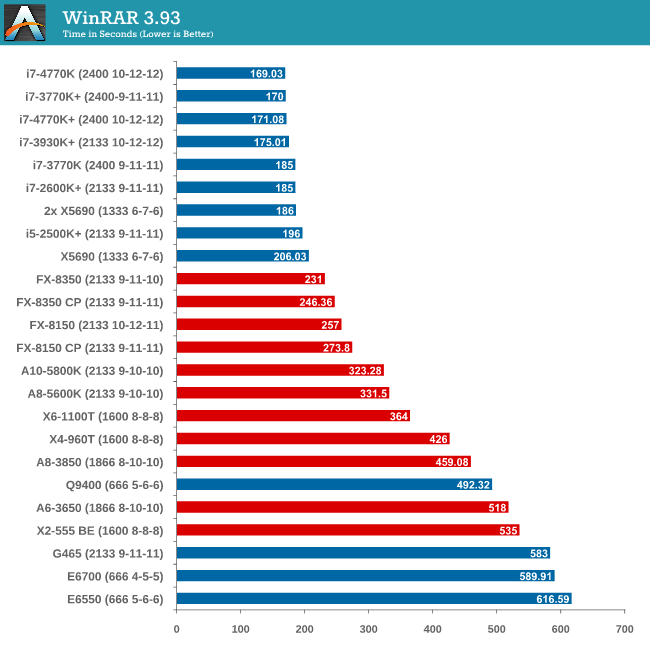
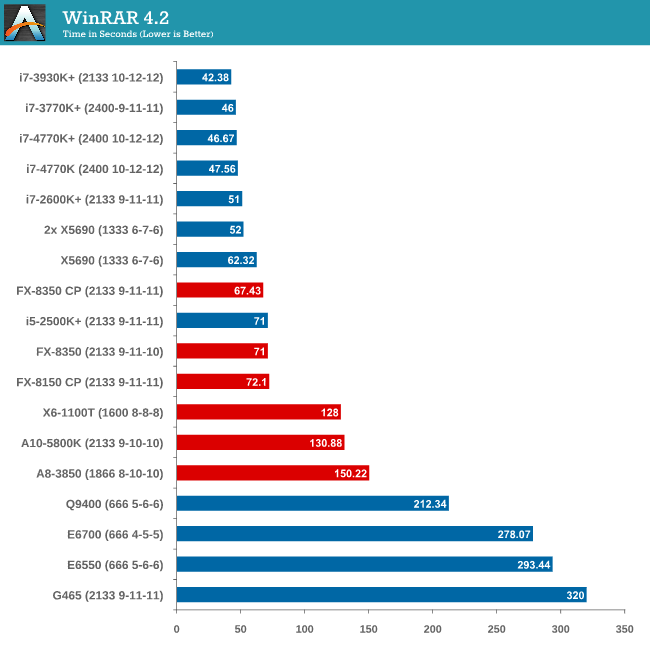
Due to the late inclusion of 4.2, our results list for it is a little smaller than I would have hoped. But it is interesting to note that with the Core Parking updates, an FX-8350 overtakes an i5-2500K with MCT.
Image Manipulation - FastStone Image Viewer 4.2
FastStone Image Viewer is a free piece of software I have been using for quite a few years now. It allows quick viewing of flat images, as well as resizing, changing color depth, adding simple text or simple filters. It also has a bulk image conversion tool, which we use here. The software currently operates only in single-thread mode, which should change in later versions of the software. For this test, we convert a series of 170 files, of various resolutions, dimensions and types (of a total size of 163MB), all to the .gif format of 640x480 dimensions.
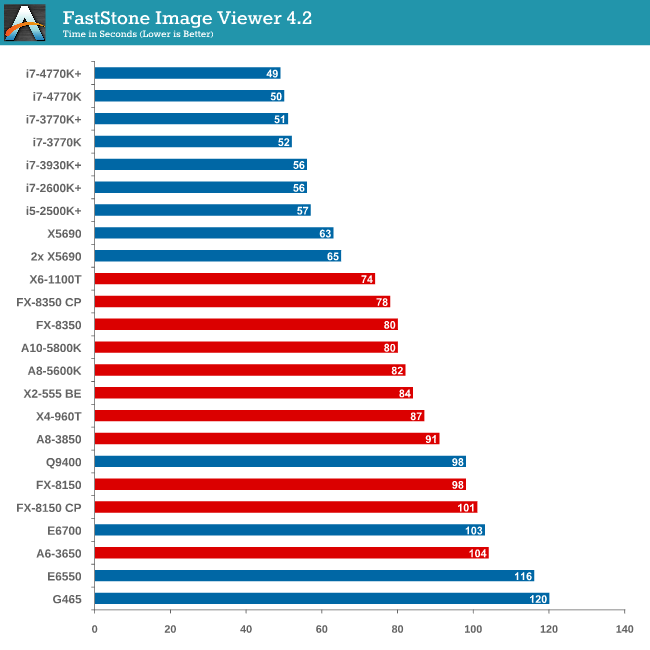
In terms of pure single thread speed, it is worth noting the X6-1100T is leading the AMD pack, and the 4770K takes the top spot. .
Video Conversion - Xilisoft Video Converter 7
With XVC, users can convert any type of normal video to any compatible format for smartphones, tablets and other devices. By default, it uses all available threads on the system, and in the presence of appropriate graphics cards, can utilize CUDA for NVIDIA GPUs as well as AMD WinAPP for AMD GPUs. For this test, we use a set of 33 HD videos, each lasting 30 seconds, and convert them from 1080p to an iPod H.264 video format using just the CPU. The time taken to convert these videos gives us our result.
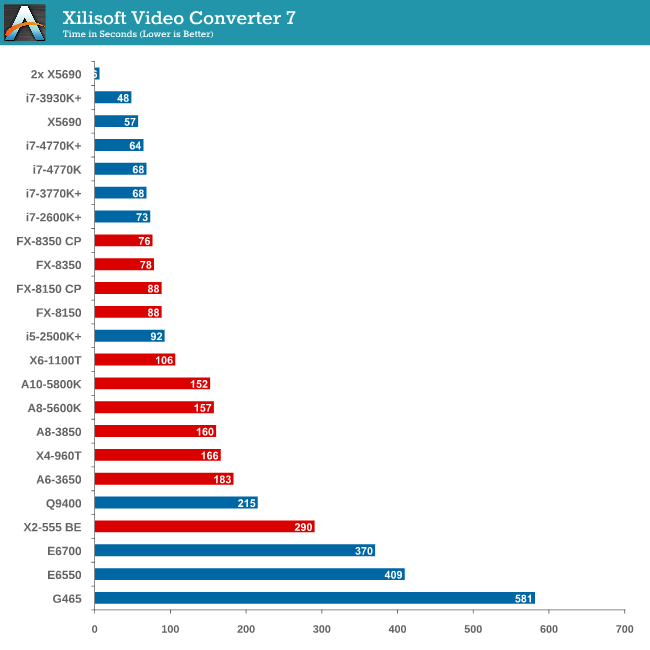
XVC is a little odd in how it arranges its multicore processing. For our set of 33 videos, it will arrange them in batches of threads – so if we take the 8 thread FX-8350, it will arrange the videos into 4 batches of 8, and then a fifth batch of one. That final batch will only have one thread assigned to it (!), and will not get a full 8 threads worth of power. This is also why the 2x X5690 finishes in 6 seconds but the normal X5690 takes longer – you would expect a halving of time moving to two CPUs but XVC arranges the batches such that there is always one at the end that only gets a single thread.
Rendering – PovRay 3.7
The Persistence of Vision RayTracer, or PovRay, is a freeware package for as the name suggests, ray tracing. It is a pure renderer, rather than modeling software, but the latest beta version contains a handy benchmark for stressing all processing threads on a platform. We have been using this test in motherboard reviews to test memory stability at various CPU speeds to good effect – if it passes the test, the IMC in the CPU is stable for a given CPU speed. As a CPU test, it runs for approximately 2-3 minutes on high end platforms.
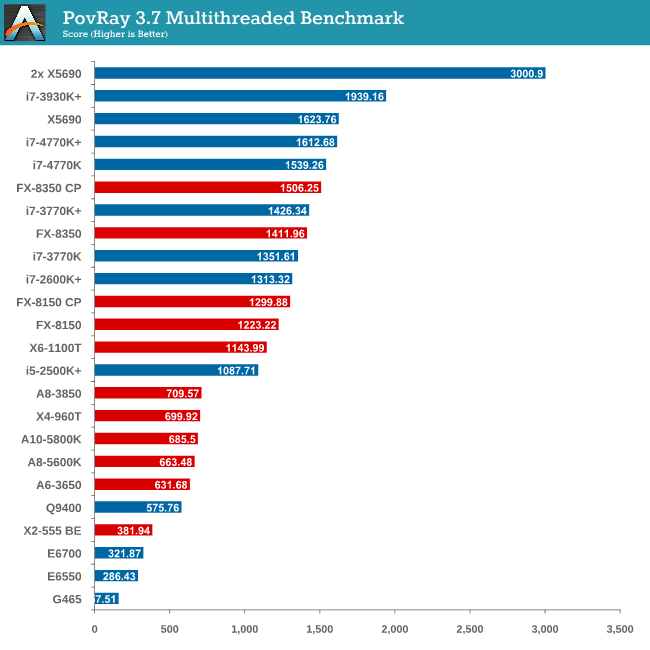
The SMP engine in PovRay is not perfect, though scaling up in CPUs gives almost a 2x effect. The results from this test are great – here we see an FX-8350 CPU below an i7-3770K (with MCT), until the Core Parking updates are applied, meaning the FX-8350 performs better! The 4770K also has a chance to flex its compute muscles, performing almost as well as the 8-core Westmere CPU.
Video Conversion - x264 HD Benchmark
The x264 HD Benchmark uses a common HD encoding tool to process an HD MPEG2 source at 1280x720 at 3963 Kbps. This test represents a standardized result which can be compared across other reviews, and is dependent on both CPU power and memory speed. The benchmark performs a 2-pass encode, and the results shown are the average of each pass performed four times.
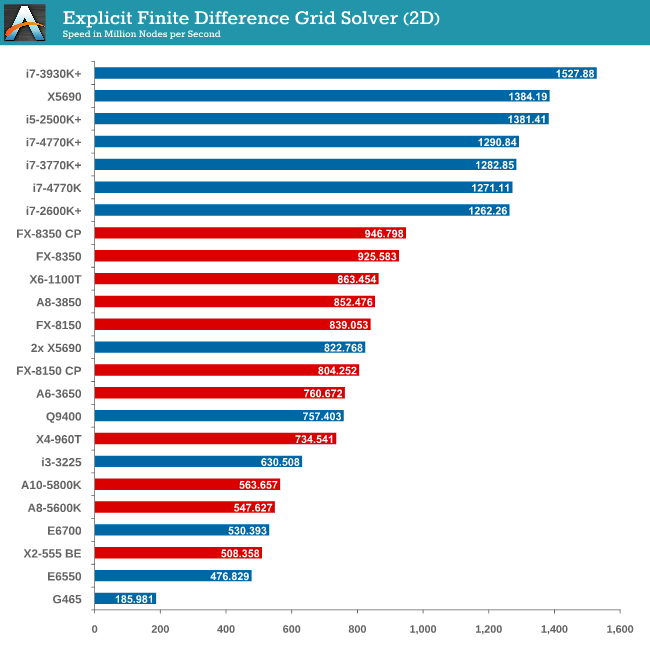
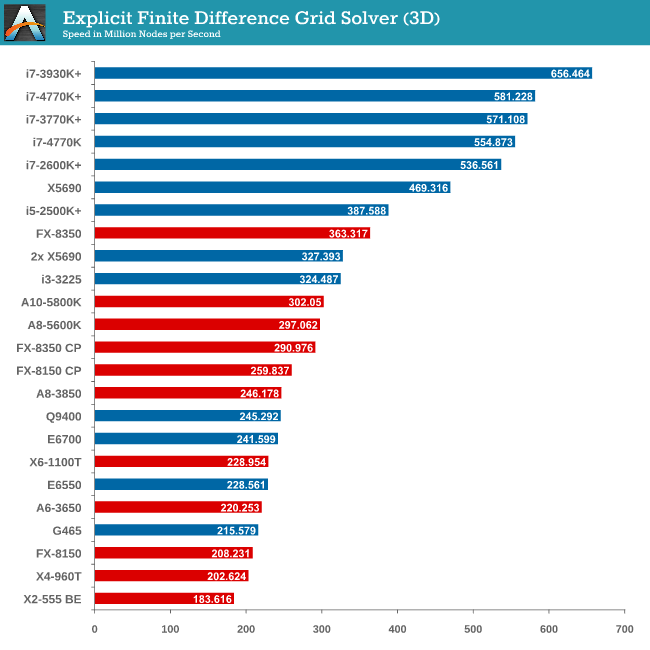
Grid Solvers - Explicit Finite Difference
For any grid of regular nodes, the simplest way to calculate the next time step is to use the values of those around it. This makes for easy mathematics and parallel simulation, as each node calculated is only dependent on the previous time step, not the nodes around it on the current calculated time step. By choosing a regular grid, we reduce the levels of memory access required for irregular grids. We test both 2D and 3D explicit finite difference simulations with 2n nodes in each dimension, using OpenMP as the threading operator in single precision. The grid is isotropic and the boundary conditions are sinks. Values are floating point, with memory cache sizes and speeds playing a part in the overall score.
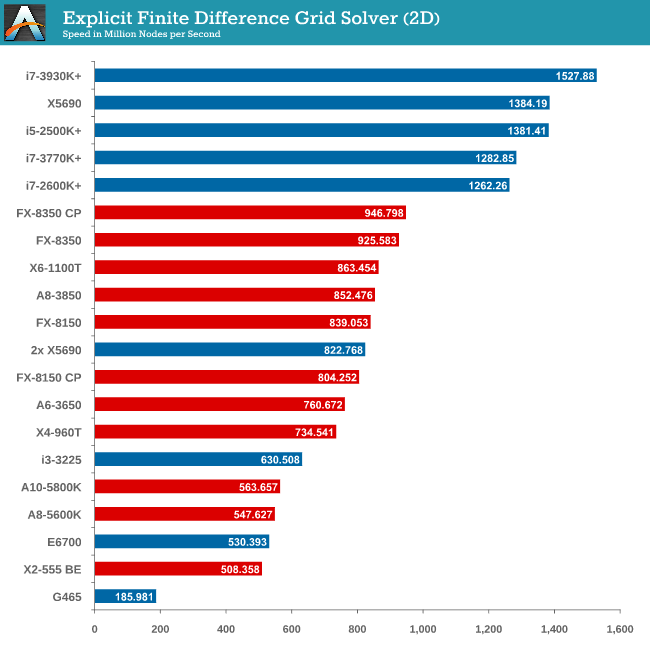
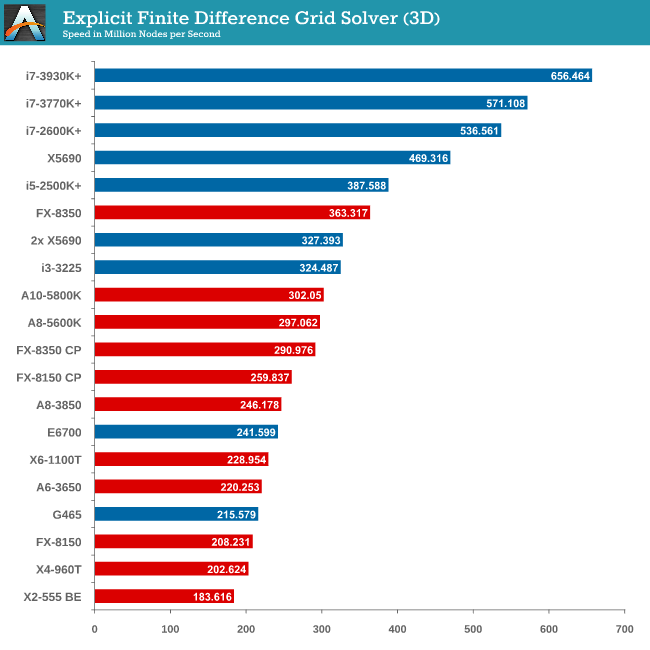
Grid solvers do love a fast processor and plenty of cache in order to store data. When moving up to 3D, it is harder to keep that data within the CPU and spending extra time coding in batches can help throughput. Our simulation takes a very naïve approach in code, using simple operations.
Grid Solvers - Implicit Finite Difference + Alternating Direction Implicit Method
The implicit method takes a different approach to the explicit method – instead of considering one unknown in the new time step to be calculated from known elements in the previous time step, we consider that an old point can influence several new points by way of simultaneous equations. This adds to the complexity of the simulation – the grid of nodes is solved as a series of rows and columns rather than points, reducing the parallel nature of the simulation by a dimension and drastically increasing the memory requirements of each thread. The upside, as noted above, is the less stringent stability rules related to time steps and grid spacing. For this we simulate a 2D grid of 2n nodes in each dimension, using OpenMP in single precision. Again our grid is isotropic with the boundaries acting as sinks. Values are floating point, with memory cache sizes and speeds playing a part in the overall score.
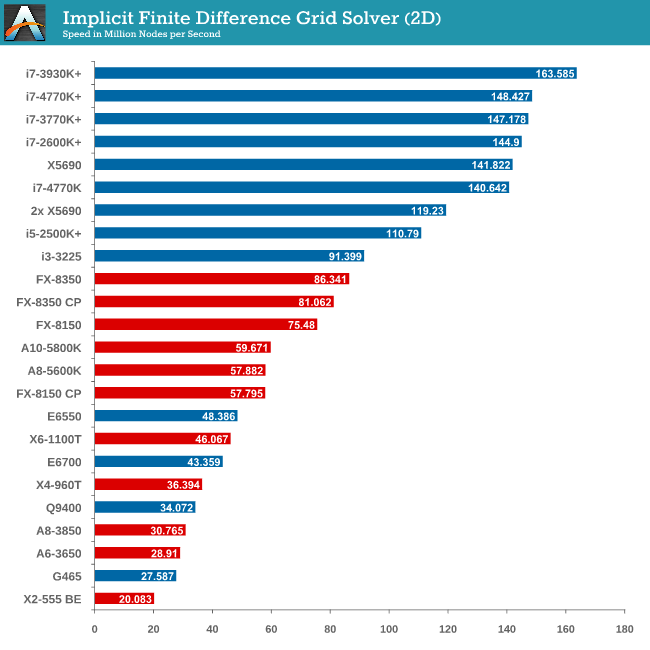
2D Implicit is harsher than an Explicit calculation – each thread needs more a lot memory, which only ever grows as the size of the simulation increases.
Point Calculations - n-Body Simulation
When a series of heavy mass elements are in space, they interact with each other through the force of gravity. Thus when a star cluster forms, the interaction of every large mass with every other large mass defines the speed at which these elements approach each other. When dealing with millions and billions of stars on such a large scale, the movement of each of these stars can be simulated through the physical theorems that describe the interactions. The benchmark detects whether the processor is SSE2 or SSE4 capable, and implements the relative code. We run a simulation of 10240 particles of equal mass - the output for this code is in terms of GFLOPs, and the result recorded was the peak GFLOPs value.
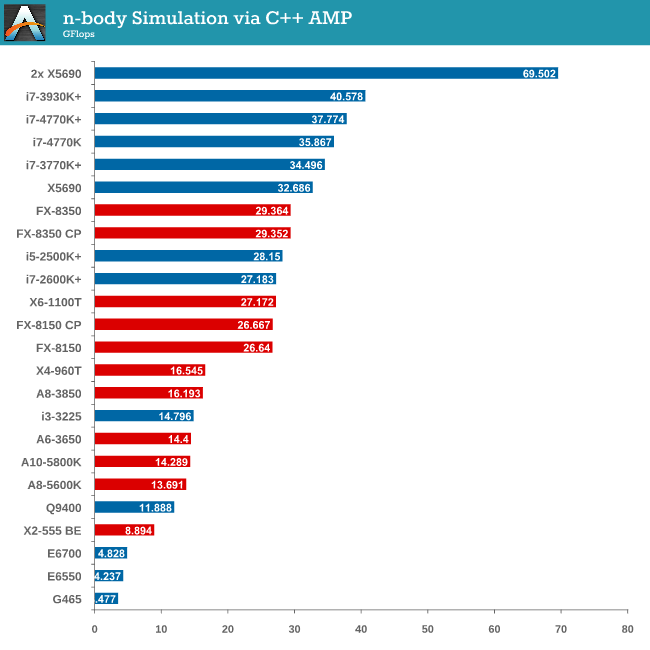
As we only look at base/SSE2/SSE4 depending on the processor (auto-detection), we don’t see full AVX numbers in terms of FLOPs.










116 Comments
View All Comments
Dentons - Tuesday, June 4, 2013 - link
He's complaint is on the mark. Haswell is about mobile, not desktop, not gaming.Ivy Bridge was about cost reduction, Haswell is about reducing TDP. It is shocking that a mid-range 2+ year old Sandy Bridge desktop part is still so very competitive, even though it's been superseded by two whole generations.
Intel deserves all this criticism and more. They've clearly put the interests of desktop users and gamers far onto the back burner. They're now focused on almost entirely mobile and are treading water with everything else.
takeship - Tuesday, June 4, 2013 - link
Eh, how can you blame them? The pure play desktop market has been shrinking for a while now, with high performance desktop (basically gamers) even more of a niche. Maybe if they had some real competition from AMD in single threaded perf... A lot of this is just Amdahl's law at it's natural conclusion. The easy performance gains are mostly gone, so if you're Intel do you dump endless money into another 25-30% per generation, or go after the areas that haven't been well optimized yet instead? Not a hard choice to make, especially considering the market moves towards mobile & cool computing in the last decade.Silma - Wednesday, June 5, 2013 - link
Intel doesn't deserve criticism. Haswell is a small improvement over Ivy Bridge because it has become extremely difficult to optimize and already excellent processor. Do you see anything better from AMD, ARM, Oracle or others?Is there a need to upgrade from Ivy to Haswell? No. Was it necessary to upgrade from Nethalem to Sandy Bride? No. The fact is that for most applications processors have been good enough for years and money is better spent on ssds, gpus and whatnot.
The real conclusion of this article should be that processors absolutely do not matter for gaming and that the money is better spent on speedier gpu. Processors may become relevant for the very very very few people that have extreme 2/3x extreme cards. Even a setup with 2 middle cards such as gtx 560 is not cpu dependent. I would welcome actual statistics from the number of players with 2x 3x high-end gpus. I'm quite sure the count is ultra tiny and for those people willing and able to spend thousand of dollars, do you think 100$ less on a processor is relevant?
chizow - Wednesday, June 5, 2013 - link
I don't have a problem with the conclusion he comes to, complaining about dissemination of information to come to that conclusion is what makes no sense. Put all the information out there, 1, 2, 3 articles a day np, then make your own informed decision on the platform. Bemoan the fact there is actual coverage a day or two after launch and one or two reviews? Makes no sense.Memristor - Tuesday, June 4, 2013 - link
Too bad that Richland, which is available as of today, didn't make it into this review. Other than that great read.eddieobscurant - Tuesday, June 4, 2013 - link
many of us have a q6600 @ 3600mhz, and personally i'm very happy this and my 7870. I would still like to see a comparison of my cpu @ 3600mhz, with the modern cpus because i don't think there is a huge difference in games.chizow - Tuesday, June 4, 2013 - link
It depends what you play, any game that is CPU limited is going to be HUGE difference with that CPU. I had the same chip at 3.6GHz, which was great btw, and even when I upgraded to 920 @4GHz there was huge improvement in some games, most notably GTA4 at the time. Some other games that scale extremely well with CPU are WoW, Diablo 3, etc. just to name a few.medi02 - Wednesday, June 5, 2013 - link
Nah. Most of the tests show that to get CPU limited you need a multi-GPU setup.i7 and intel mobo will cost you about 500$ with marginal improvements.
chizow - Wednesday, June 5, 2013 - link
Sorry, just not true. Even with just 1x680 WoW and other similarly CPU dependent games scale tremendously well with faster CPUs:http://www.tomshardware.com/reviews/fx-8350-visher...
Q6600 @ 3.6 is probably just a tad faster than the Phenom IIs in that test.
TheJian - Thursday, June 6, 2013 - link
See my comments here...Chizow is correct, and even understating it some. There are a LOT of games cpu limited as I showed in my links. Huge differences in cpu perf from A10-5800 up to 4770k, never mind the junk Ian recommends here A8-5600 for single gpu. It just isn't correct to recommend that cpu or even A10-5800K which I showed getting smacked around in many games at 1080p. Articles like this make people think games are not cpu bound (it's far more games than Civ5). Neverwinter, Metro Last light, tomb raider, Farcry3, Crysis 3 etc etc...Once 20nm comes we may find even 1440p showing just as many limited by cpu. If rumors are true Volcanic doubles stream processors. I'm sure NV will match that. You end up gpu bound when you up the res to 1440 on single cards now, but that won't be forever and 98.75% of us according to steam don't play at 1440p (.87%) or above (1.25% total of all res above 1920x1200).Check the 1080p data on my links (techreport was a good one as they show 1080p in most of the listed games). Toms shows neverwinter as I noted needing a very high cpu also. Hit all comments on this article, and Ctrl-F my name. Ignore my post comments and just click the links in them to prove Chizow's point (and my own). CPU is important at 1080p and 1920x1200 NOW and will be important at higher res with the next gen cards at 20nm. You will never get out of your AMD mistake if you take this article's suggestions. Well at least not without changing to an Intel board/chip...LOL. Who wants to do that? Just buy an Intel unless you're broke. Don't trust me though, read the links provided and judge for yourself how accurate anandtech is here.
I showed some games that are nearly DOUBLE on Intel vs. A10-5800K! You don't have to like the way I made my point or believe me, just check the links :) They all say the same thing. CPU is an issue just as Chizow shows in his link. You can find this in many cpu articles where they use a top gpu (usually 7970/680) and test new cpus with the oldies in there too which show large separations. Check i7-3770k or fx 8350 articles (just google those two cpu models and "review" for ample sites showing the spreak)...1080p separates the men from the boys in cpu's.
After you check the links (and chizow's), come back and agree Anandtech needs to change their ways, or tear my comments apart if I'm lying :) Future gpu's will only make our point stick out even more. CPU matters. Also note a lot of the games that are gpu limited on single cards are NOT playable anyway (check sleeping dogs right here in this article 1440p...7970 at 28fps avg is NOT playable, mins will dip to 20's or below). So you're forced back into cpu limited in a lot of cases at 1080p. Where 98.75% of us play you see cpu limits a lot.
Go back one page on Chizow's link to Skyrim's benchmark in the same article for the same data. 1080p 3770 scores 88.2 to 8350's 67.4 (that's a lot and a huge hint to how your future on AMD will look)
http://www.tomshardware.com/reviews/fx-8350-visher...
That's a 30% difference and an 8350FX is far faster than an A8-5600 Ian recommends here. Chizow is even more right if you toss in Ian's recommendation of an even slower cpu than 8350 vs. Intel's stuff. Even in skyrim at 1680x1050 they separate from 90fps to 68fps for 8350fx. So until you completely tap out your gpu (1440p and up which basically requires 2+ cards) you will notice if your cpu is junk or not. Since this article is only written for apparently 1.25% of the readership (or world for that matter according to steam survey), you will notice the cpu! Unless you're raising your hand as the 1.25% :) I don't call 30-100% faster marginal improvements do you? Add CIV 5 also which this site even proves in this article ;) At least they got something right.